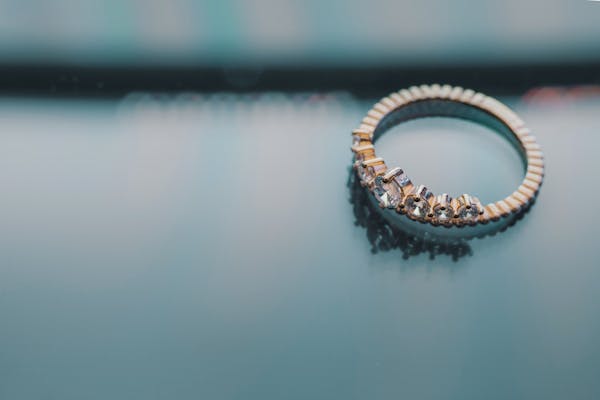Luxury diamonds are more than just beautiful — they’re precise, rare, and incredibly valuable. Whether you’re investing in fine jewelry or choosing a diamond engagement ring, understanding how diamonds are graded is essential. Without this knowledge, it’s easy to overpay or select a stone that doesn’t meet your expectations.
In this complete guide, you’ll learn how luxury diamonds are evaluated, what makes one diamond more valuable than another, and how to make a smart, informed choice when buying high-end diamonds.
What Is Diamond Grading?
Diamond grading is the process of evaluating a diamond’s quality based on internationally accepted standards. The most widely used system is the 4Cs grading method developed by the Gemological Institute of America (GIA), which assesses Cut, Color, Clarity, and Carat Weight.
These grades help determine a diamond’s market value and are essential in comparing one diamond to another. Top luxury jewelers rely on reputable grading reports to certify their diamonds, ensuring transparency and trust for buyers.
The 4Cs of Diamond Grading
Each of the 4Cs plays a vital role in determining a diamond’s appearance, quality, and value. Here’s a breakdown of what each element means and how it affects luxury diamonds.
Cut
Cut refers to how well a diamond’s facets reflect light. It directly affects the stone’s brilliance and sparkle.
- Excellent or Ideal Cut: Maximum brilliance; preferred for luxury stones
- Very Good Cut: Strong light performance, slightly lower than ideal
- Good or Fair Cut: Less sparkle; often found in budget-friendly diamonds
In luxury diamonds, cut is the most critical factor. Even a flawless diamond won’t sparkle if it’s poorly cut.
Color
Color is graded on a scale from D (colorless) to Z (noticeable yellow or brown tint).
- D–F (Colorless): Highest quality, rarest, and most valuable
- G–J (Near Colorless): Slight tint, barely visible to the naked eye
- K–Z: Increasingly visible color, less desirable in high-end diamonds
Luxury diamonds typically fall in the D–F range for their pristine, icy appearance.
Clarity
Clarity measures the presence of inclusions (internal flaws) or blemishes (external marks).
- Flawless (FL): No inclusions or blemishes visible under 10x magnification
- Internally Flawless (IF): No internal inclusions
- Very Slightly Included (VS1, VS2): Minute inclusions, difficult to detect
- Slightly Included (SI1, SI2): Noticeable inclusions under magnification
For luxury diamonds, FL to VS1 clarity levels are most desirable, offering near-perfect visual purity.
Carat Weight
Carat measures the weight of the diamond. One carat equals 200 milligrams.
- Larger diamonds are rarer and command higher prices
- Carat weight should be balanced with cut, clarity, and color for optimal value
- Two diamonds of the same carat can have vastly different prices based on the other Cs
In luxury jewelry, it’s common to find diamonds over 1 carat — but quality still trumps size.
Who Grades Luxury Diamonds?
For a diamond to be considered truly “luxury,” it must be certified by a reputable grading institution. The most respected organizations include:
GIA (Gemological Institute of America)
- Known for strict grading standards
- GIA reports are widely trusted and accepted worldwide
- Most luxury brands rely on GIA certificates for their diamonds
AGS (American Gem Society)
- Offers similar standards to GIA, with a focus on light performance
- AGS 0 (zero) is considered the ideal grade in their system
HRD Antwerp
- European-based grading lab with solid reputation
- Commonly used by high-end jewelers in Europe
IGI (International Gemological Institute)
- Recognized globally, though generally considered less strict than GIA or AGS
- Often used for commercial diamonds, less common in ultra-high-end jewelry
Always ask for a grading report before purchasing a luxury diamond. It’s the best way to verify you’re getting what you’re paying for.
Additional Grading Factors for Luxury Diamonds
While the 4Cs are foundational, luxury diamond grading goes further. Discerning buyers and elite jewelers often consider extra details that affect beauty and value.
Fluorescence
Fluorescence describes how a diamond reacts under ultraviolet light.
- None to Faint: Preferred in luxury diamonds
- Strong to Very Strong: Can cause a hazy or oily appearance in daylight
Though not part of the 4Cs, fluorescence can influence a diamond’s price and appearance.
Symmetry and Polish
- Symmetry: Refers to the alignment of a diamond’s facets
- Polish: The smoothness of the diamond’s surface
Top-grade diamonds will be labeled Excellent in both categories on the grading report, enhancing overall brilliance.
Origin and Ethical Certification
High-end buyers increasingly value ethical sourcing and sustainability.
- Look for Kimberley Process Certification to ensure conflict-free diamonds
- Some luxury brands offer traceable origin through blockchain or mine-to-market programs
Brands like Tiffany & Co., Chopard, and De Beers offer transparency in sourcing — a hallmark of modern luxury.
How Luxury Brands Use Diamond Grading
Top luxury jewelry houses do not rely solely on certification — they also curate their own standards.
- Tiffany & Co. uses only diamonds with no visible inclusions to the naked eye
- Harry Winston selects diamonds in the highest ranges of color and clarity
- Graff works with some of the rarest and most flawless diamonds on Earth
These internal standards ensure that each stone reflects the brand’s identity and exclusivity.
Why Diamond Grading Matters for Investment
Understanding grading is essential not only for personal purchases but also for investment value. A well-graded diamond from a top brand can:
- Retain or appreciate in value over time
- Perform well at auction or resale
- Be passed down as a high-value heirloom
Grading reports also provide proof of authenticity and make it easier to insure your jewelry accurately.
Tips for Buying a Graded Luxury Diamond
- Always ask for a GIA or AGS certificate
- Compare diamonds side-by-side to understand how grades impact appearance
- Focus on overall beauty, not just numbers — a well-balanced diamond often looks better than one that is perfect in only one category
- Work with reputable luxury retailers who offer guarantees and full disclosure
- Get an independent appraisal if you’re buying second-hand or at auction
Luxury diamond grading is complex, but with the right guidance, you can choose a stone that’s not only stunning but also a solid long-term investment.
Understanding luxury diamond grading is the key to buying with confidence. Whether you’re purchasing for love, legacy, or long-term investment, the 4Cs — combined with additional quality factors — provide a reliable framework for decision-making.
From clarity to cut and ethical sourcing, luxury is defined not just by price, but by precision and provenance. Armed with the knowledge in this guide, you’re now equipped to select a diamond that will shine forever — in both beauty and value.




